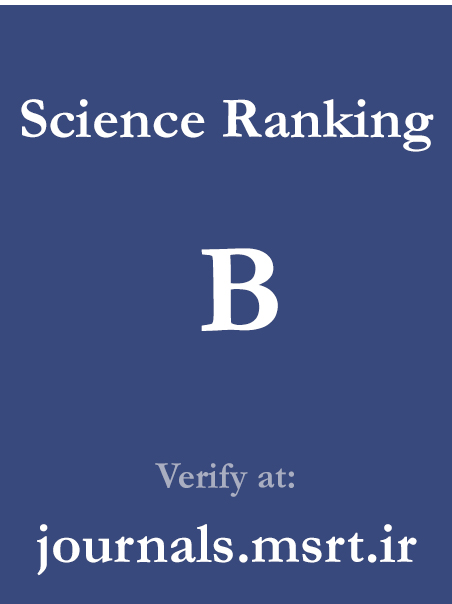Quantitative Analysis of Factors Affecting the Realization of Smart Government in Iran with Emphasis on the Dimensions of Digital Governance
Keywords:
Smart Government, Structural Equation Modeling (SEM), Digital Transformation, Information Technology Infrastructure, Citizen ParticipationAbstract
This study aims to quantitatively examine the factors affecting the realization of smart government in Iran with an emphasis on the dimensions of digital governance. The research employed a descriptive-correlational survey design and targeted experts and managers in the field of information technology and digital transformation in Iran’s public sector. A structured questionnaire was used to collect data from a sample of 384 participants selected via purposive sampling. The instrument measured constructs such as IT infrastructure, digital governance, organizational agility, digital policymaking, and citizen participation. Data analysis was conducted using SPSS and AMOS software. Structural Equation Modeling (SEM) was employed to test hypothesized relationships and evaluate the measurement and structural models. Inferential statistical analysis using SEM confirmed that all hypothesized relationships were statistically significant at p < 0.001. IT infrastructure (β = 0.804, t = 9.653), comprehensive service delivery (β = 0.308, t = 7.118), choice provision (β = 0.760, t = 9.35), security (β = 0.809, t = 9.39), goal alignment (β = 0.654, t = 12.34), smart services (β = 0.756, t = 7.118), and other factors such as digital governance, digital roadmaps, and smart interaction showed significant positive effects on the realization of smart government. Digital policymaking and digital governance emerged as the strongest predictors. The model’s goodness-of-fit index (GOF = 0.56) indicated a strong overall model fit. The coefficient of determination (R²) for the final structural model was 0.72, demonstrating high explanatory power. The realization of smart government in Iran is significantly influenced by a combination of digital infrastructure, governance mechanisms, policymaking strategies, organizational agility, and civic engagement. Among these, strategic digital policymaking and robust digital governance play pivotal roles. These findings underscore the need for integrated digital strategies and institutional capacity building to support the digital transformation of public administration in Iran.
Downloads
References
Alajmi, M., Mohammadian, M., & Talukder, M. (2023). The Determinants of Smart Government Systems Adoption by Public Sector Organizations in Saudi Arabia. Heliyon, 9(10). https://doi.org/10.1016/j.heliyon.2023.e20394
Anthopoulos, L. G., & Reddick, C. G. (2023). Smart City and Smart Government: Synonymous or Complementary? 25th International Conference Companion on World Wide Web, https://doi.org/10.1145/2872518.2888615
Chatfield, A. T., & Reddick, C. G. (2019). A Framework for Internet of Things-Enabled Smart Government: A Case of IoT Cybersecurity Policies and Use Cases in U.S. Federal Government. Government Information Quarterly, 36(2). https://doi.org/10.1016/j.giq.2018.09.007
Deandra, R. A., Nurmandi, A., & Fridayani, H. D. (2024). Implementation of Smart Government, Smart Mobility, and Smart Living Policies in Realizing the Quality of Public Services in Yogyakarta City. Jurnal Ilmu Pemerintahan Kajian Ilmu Pemerintahan Dan Politik Daerah, 9(2), 139-152. https://doi.org/10.24905/jip.9.2.2024.139-152
Ghaffari, P., Pourezzat, A. A., Araei, V., & Alvani, S. M. (2023). Designing a Model of Smart Urban Governance Using a Synthesis Approach. Journal of Public Administration, 15(3), 400-438. https://doi.org/10.22059/jipa.2023.358375.3323
Gholami, Z., Shafiei, S., & Barakhas, H. (2024). The Role of E-Government in Employee Performance at the Sports and Youth Administration of Qazvin Province With the Mediating Role of Organizational Transparency. Sports Management Studies. https://smrj.ssrc.ac.ir/article_4324.html?lang=en
Guenduez, A., Frischknecht, R., Frowein, S., & Schedler, K. (2024). Government-University Collaboration on Smart City and Smart Government Projects: What Are the Success Factors? Cities, 144. https://doi.org/10.1016/j.cities.2023.104648
Kankanhalli, A. (2019). IoT and AI for Smart Government: A Research Agenda. Government Information Quarterly, 36(2), 304-309. https://doi.org/10.1016/j.giq.2019.02.003
Popescu, M. A. M., Barbu, A., Costea-Marcu, I.-C., & Dumitriu, D. (2024). Conceptual Framework for Unified E-Government Web Platform. Proceedings of the International Conference on Business Excellence, 18(1), 3503-3514. https://doi.org/10.2478/picbe-2024-0284
Raeisi, N., Jafarinea, S., & Zare, H. (2024). Testing the Model for Enhancing Administrative Transparency in Interaction with E-Government Development Programs in the Social Security Organization. Dynamic Management and Business Analysis, 3(1), 320-334. https://doi.org/10.61838/dmbaj.3.1.18
Rahmadanita, A., Santoso, E. B., & Wasistiono, S. (2019). Implementasi Kebijakan Smart Government Dalam Rangka Mewujudkan Smart City Di Kota Bandung. Jurnal Ilmu Pemerintahan Widya Praja, 44(2), 81-106. https://doi.org/10.33701/jipwp.v44i2.279
Raza, M. A. (2024). Cyber Security and Data Privacy in the Era of E-Governance. Social Science Journal for Advanced Research, 4(1), 5-9. https://doi.org/10.54741/ssjar.4.1.2
Savić, D. (2022). Digital Transformation and the Public Sector: Smart Government for the Future. Taylor & Francis. https://www.researchgate.net/publication/368632698_Digital_Transformation_in_the_Public_Sector
Shahzad, K., Tahir, Z., Cheema, U., & Ahmad, M. A. (2024). Barriers Towards Adoption of E-Government Services. Journal of Business and Social Review in Emerging Economies, 10(2). https://doi.org/10.26710/jbsee.v10i2.2966
Shakouri-Moghadam, M. (2018). On the Configuration of Smart Government for Good Governance. Tehran: Simak. https://nahang.ir/book/721804/
Shan, S., Duan, X., Zhang, Y., Zhang, T., & Hui Li, T. (2021). Research on Collaborative Governance of Smart Government Based on Blockchain Technology: An Evolutionary Approach. Discrete Dynamics in Nature and Society, 2021. https://doi.org/10.1155/2021/6634386
Sharifian, D. (2018). Organizational Management in the Age of Information and Knowledge: The Necessity of Achieving Smart Government. Tehran: Aroon. https://arvannashr.ir/product/
Sharifian, D., Bab Al-Hawaeji, F., & Abazari, Z. (2021). Presenting a Model of Digital Identity in Smart Government in Iran's Public Sector with the Mediating Role of Digital Transformation Leadership. Knowledge Studies Quarterly, 14(52), 31-51. http://ensani.ir/fa/article/532522/
Wirtz, B. J., Weyerer, C., & Schichtel, F. (2019). An Integrative Public IoT Framework for Smart Government. Government Information Quarterly, 36(2), 333-345. https://doi.org/10.1016/j.giq.2018.07.001
Yazdani, A., & Darbani, S. (2022). The Impact of Cloud Technology on Strategic Management and Organizational Flexibility. Journal of Technology in Entrepreneurship and Strategic Management, 1(1), 12-20. https://www.journaltesm.com/article_192386.html
Zhang, J., & Mora, L. (2023). Nothing But Symbolic: Chinese New Authoritarianism, Smart Government, and the Challenge of Multi-Level Governance. Government Information Quarterly, 40. https://doi.org/10.1016/j.giq.2023.101880
Downloads
Published
Submitted
Revised
Accepted
Issue
Section
License
Copyright (c) 2025 Babak Fathi (Author); Gholamreza Rahimi (Corresponding author); Farhad Nejhad Haji Ali Irani (Author)

This work is licensed under a Creative Commons Attribution-NonCommercial 4.0 International License.







